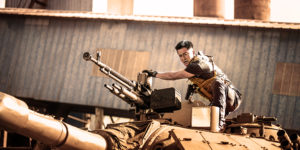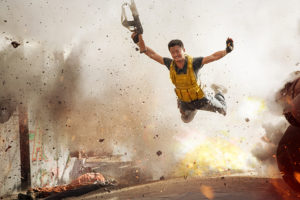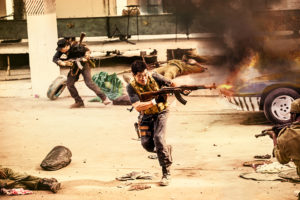By Dr. Craig D. Reid
 Written, directed and starring Wu Jing, Wolf Warrior II (Wolf2) is such a wild and wooly, often times wacky, of the wall and a wonderfully yowling and howling movie, which due to it being the highest grossing modern-day war film in cinema history ($870 million in 49 days), that makes Wolf2 the alpha war movie male and truly the leader of the pack.
Written, directed and starring Wu Jing, Wolf Warrior II (Wolf2) is such a wild and wooly, often times wacky, of the wall and a wonderfully yowling and howling movie, which due to it being the highest grossing modern-day war film in cinema history ($870 million in 49 days), that makes Wolf2 the alpha war movie male and truly the leader of the pack.
Set in an undistinguished country in Africa undergoing a horrific revolution, where the blood thirsty rebel leader has hired European mercenaries to do his dirty deeds in killing civilians and government troops, when the mercenaries led by Big Daddy (Frank Grillo, Brock Rumlow/Crossbones villain in Captain America: The Winter Soldier) decide to tackle a former Wolf Warrior Chinese Special Forces operative named Leng Feng (Wu), who’s trying to protect and lead a group of Chinese citizens and their African friends to safety ala Bruce Willis’ Tears of the Sun (2003), Leng goes Rambo III on them.
Similar to Sly Stallone’s Rambo character who armed with a machine gun, takes on the whole Russian army, which is loaded with tanks, hundreds of troops, machine guns and explosives up the waazoo, while protecting a wee Afghanistan waif, Wu takes Leng’s efforts to a higher level. Hello, how’d he do that?

Bizarre tank fight choreography (you read that right) complements of Sam Hargrave, action director for Captain America: Civil War, which increased Wolf2′s production value of the explosions and tank battles on par with Hollywood films. And as is still usual, what sets apart Chinese films from American movies, is the martial arts stylized action seen during one-on-one and one-against-many duels underwater, in the bloodbath streets and on the battle field. All the while Leng’s thinking about his portly godson waif Tundu and how to find Tundu’s lost mother.
Also written, directed and starring by Wu, in China’s first domestically-made 3D action film Wolf Warrior, when Chinese Special Forces sniper Leng Feng disobeys orders and unorthodoxly shoots a wanted criminal, the brother of a powerful and nefarious drug lord, he’s kicked off the force and put in prison. Yet due to his gumption, magnificent marksmanship and fighting prowess, Leng is recruited to join the ultra-elite fighting unit Wolf Warriors to hunt down and arrest the drug lord, who in turn hires a vicious group of mercenaries led by the lethal Tomcat (legitimate British martial artist Scott Adkins) to annihilate the Wolf Warriors and assassinate Leng for killing his brother.

It’s important to note that Wu is not the next Jackie Chan or heir to Chan, making that comparison is like saying Stallone was the next John Wayne. It’s just the laziness of film critics who don’t know Chinese films and don’t know how to describe Wu. When it comes to fight choreography and views on action…Wu is influenced by Donnie Yen, Jet Li, Yuen Woo-ping and himself.
A man of Manchu descent, Wu began practicing wushu at age six then similar to Li, became a member of the Beijing Wushu team and like Yen was cinematically discovered by Yuen Woo-ping (Matrix (1999) and Crouching Tiger, Hidden Dragon (2000) action director), who cast Wu in Tai Chi II (1996), a sequel to Li’s classic The Tai Chi Master (1992). He’s known by American filmgoers for his roles in Yen’s SPL (2005) and fighting Tony Jaa in SPL: A Time for Consequences (aka Kill Zone 2 (2015). Yet with the blazing success of Wolf2, he’s now a household name in China and in a place to challenge Hollywood’s cinematic grip on the world. It’s not Chinawood, but Chinawill.
Knowing Wolf Warriors was targeted to be a trilogy and thus three scripts were already in place, Wu prepared for the films by training for 18 months with the PLA (China’s People’s Liberation Army) in a Nanjing Military unit. The training paid off even more in Wolf2 where the gunfights are as cool as 10 of John Wu’s best ballistic ballets plus two and magnificent pugilistic mayhem that begins with Leng battling four, gun-shooting, knife-wielding martial pirates underwater in one breath, ending the duel by showing the audience his superior sniping skills. It’s wild to witness.
Wu Jing Fights
 Rumors reported that the underwater fight was a six-minute one-take action scene, When asked if that were true Wu humbly proffers, “No one can perform action scenes underwater for two minutes, but I liked the idea to challenge what others have not done. Yuen Woo-ping once told me that as an actor, you should ask yourself if you’re ready or not, grow your abilities and let your skills be in your hands. Don’t realize they’re helpful just on the day of shooting.”
Rumors reported that the underwater fight was a six-minute one-take action scene, When asked if that were true Wu humbly proffers, “No one can perform action scenes underwater for two minutes, but I liked the idea to challenge what others have not done. Yuen Woo-ping once told me that as an actor, you should ask yourself if you’re ready or not, grow your abilities and let your skills be in your hands. Don’t realize they’re helpful just on the day of shooting.”
Wu invited the underwater photographer who shot Pirates of the Caribbean to shoot the fight and noted that he, four attackers, the photographer and underwater deputy director didn’t use any breathing apparatus. For safety, five lifeguards were always nearby.
Wu adds, “One problem was having five fighters underwater with 10 groups of bubbles. How to avoid extra bubbles, how could my partner kick faster than me, avoid me and pick up my actions? These technical difficulties were solved by the photographer.”
When a rebel attack fills the streets with bloodlust, you know this fight will be special when after a rebel fires at rocket grenade at Leng and Tunda, Leng grabs an old bed spring mattress and traps the warhead in one of the springs while the rocket motor’s fuse is still burning. In theory that would work since a warhead detonates on impact of the tip or when the rocket motor burns out. The audacity of this idea is avant-garde to the hilt.

The finale duel between Wu and Grillo isn’t as exciting as Wolf Warrior‘s Wu vs. Atkins bout. Since Grillo isn’t a fighter and thus his stunt double does most of the action, it shortchanges Wu’s skill sets as the choreography becomes diluted. To compensate and bring out the emotion of a hero brawling a powerful villain, it’s shot with a slower camera speed, tracking hits of Wu (when Wu gets hit, the camera follows him flying backward to reveal Wu’s stunt reaction) and low angle medium-wide shots of Wu, which creates elements of cool and soldier superiority.
Wu points out that action is an international language and Hollywood actors don’t allow getting punched in the face, adding, “But Chinese action actors pursue real fighting. If I used a double, audiences would be buying tickets to see substitutes and not me, I don’t want to be replaced.

“Aside from that, it’s easy to make mistakes using a double, and it generates problems for the cameramen. Moreover, I’m confident in my actions and can finish action I design. I must finish the actions with the emotions of Wu Jing so that I can touch audiences in the most authentic way. The process flow of the US team was fixed and it’s normal for them to use doubles, which is good for actors. They need actors to train in advance, and all the people exercised together and cooperated with each other so that the shooting could be smooth and convenient. They needed to follow an industrial standard, while we were always making changes on the site. Each method has its advantages and disadvantages.”
If you watch Wolf2 with an understanding of what nationalistic pride means to one’s country, where regardless of where we live, we’re looking for cinematic war heroes, like America and Britain did during World War II and most recently our fawning over Navy SEAL flag waving patriotic heroics in our fight war against terrorism in the Middle East, then it’s a proper gander way of broaching the film as compared to being a propaganda movie. Thus if we’re doing that, what’s the problem with China doing that? As the Chinese say, and I agree, “Mei yo wen ti (no problem).”
So whether your battle cry is oohrah (US Marines), hooah (US Army) or hooyah (US Navy SEALS), for Wolf Warriors 2 it’s WOW!